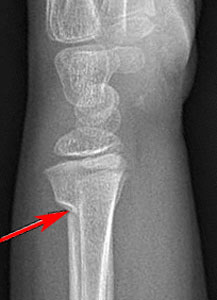
Buckle injury of the wrist Buckle fracture Figure 2. Your child should avoid rough play and contact sports, as well as activities such as trampolining and skateboarding for a total of SIX weeks after the injury. Your child’s wrist remains very painful or swollen Your child will not use their wrist, hand or fingers within 23 days of the back slab or splint being removed. This should improve over the next week or two. Expect the wrist to be stiff for a few days after removal. After three to four weeks the splint should be able to be removed and left off. This is for your child to be reassessed to make sure pain is controlled and the splint is well-fitting. You may be asked to see your GP within 1 week. This is best done overnight so that the splint can be put back on for daytime activities. Hand wash in lukewarm water with mild detergent. Splints are usually more comfortable for the child and easier to care for. Research has shown that wrist buckle fractures will heal well in a splint which gives support and protection. If severe pain continues, or if there is a lot of swelling or numbness you should bring your child to your local doctor or the Emergency Department for review. Ask your child to move their shoulder, elbow, and fingers, so they don’t get stiff. If your child gets any numbness in the hand, you should loosen the splint. Give your child the dose that is recommended on the packaging for their age and weight. Pain medication like paracetamol or ibuprofen should be given regularly until your child is comfortable. However, the splint can be taken off for bathing, or if you need to wash the splint itself, as long as the removal is well tolerated by your child (Figure 2). A removable wrist splint should be worn for comfort for three to four weeks, day and night (except when it is removed for washing and drying) to reduce the chance of further injury. These fractures heal well with rest and time. This fracture is very common in children and presents as a bulge in the bone as it has been squashed If your child has fallen onto their wrist, they may have an injury known as a “buckle” fracture (Figure 1).

Elevate your wrist above the level of your heart as often as possible. Ice helps prevent tissue damage and decreases swelling and pain. Cover it with a towel before you place it on your skin. Use an ice pack, or put crushed ice in a plastic bag. Surgical repair of pediatric hand and wrist fractures is rarely required in situations where the bone cannot be set straight or if it not healing properly with cast treatment.The two bones in your child’s forearm are called the radius and ulna. Apply ice on your wrist for 15 to 20 minutes every hour or as directed. Sometime the fracture will need to be “set” straight before splinting. Delayed treatment of pediatric fractures can lead to undesirable outcomes including malunion (bone doesn’t heal straight), and nonunion (bone doesn’t heal at all).Īnd casting are the mainstays of nonoperative treatment for fractures that are stable and not badly displaced (out of alignment). Even without these warning signs, it is best to seek urgent treatment so that the fracture can be set straight and Or “tight” swelling, significant deformity, or any open wounds around the hand or wrist (possible open or compound fracture). Suspected hand and wrist fractures warrant emergent treatment if your child is experiencing hand numbness and tingling, severe Yes! Some fractures are obvious if there is a deformity, but typically X-ray is used to definitively diagnose the fracture and plan treatment. Is There a Test for Hand and Wrist Fractures? Finger hyperextension / jamming injuries.Direct blows to the hand or wrist (sports, vehicle accidents).Fall onto an outstretched hand (most common).Most hand and wrist fractures in children are caused by injuries: The fractures occur around the soft growth plates at the wrist and bases of the fingers. Because children’s bones are more flexible than adults’, sometimes they “bend” or “buckle” like a “green stick” rather than cracking. These are all just different ways of describing a fracture. You’ve been told the bone was “broken”, “hairline”, “green stick”, “buckled”, “cracked”, “chipped”, “split”, “shattered”, or “splintered”, Fractures are simply breaks or cracks in the bone. Unfortunately, fractures are a right-of-passage for most children.

Of all ages, and when they land on their outstretched hand or wrist, injuries can occur. Kids are active, but not always graceful! Falls happen to children What Are Pediatric Hand and Wrist Fractures?


 0 kommentar(er)
0 kommentar(er)
